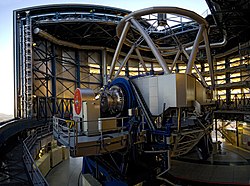ESO’s VLTI images of stars at the center of the Milky Way (noirlab2130c)
Autor/Urheber:
ESO/GRAVITY collaboration
Attribution:
Das Bild ist mit 'Attribution Required' markiert, aber es wurden keine Informationen über die Attribution bereitgestellt. Vermutlich wurde bei Verwendung des MediaWiki-Templates für die CC-BY Lizenzen der Parameter für die Attribution weggelassen. Autoren und Urheber finden für die korrekte Verwendung der Templates hier ein Beispiel.
Größe:
4500 x 1842 Pixel (626339 Bytes)
Beschreibung:
These annotated images, obtained with the GRAVITY instrument on ESO’s Very Large Telescope Interferometer (VLTI) between March and July 2021, show stars orbiting very close to Sagittarius A*, the supermassive black hole at the heart of the Milky Way. One of these stars, named S29, was observed as it was making its closest approach to the black hole at 13 billion kilometers, just 90 times the distance between the Sun and Earth. Another star, named S300, was detected for the first time in new VLTI observations
reported by ESO.Using
Gemini North of the international
Gemini Observatory, a Program of NSF’s
NOIRLab and ESO’s VLT, astronomers have measured more precisely than ever before the position and velocity of these stars S29 and S55 (as well as stars S2 and S38), and found them to be moving in a way that shows that the mass in the center of the Milky Way is almost entirely due to the Sagittarius A* black hole, leaving very little room for anything else.
Weitere Informationen zur Lizenz des Bildes finden Sie hier. Letzte Aktualisierung: Mon, 11 Nov 2024 19:18:52 GMT
Relevante Bilder
Relevante Artikel
Paranal-Observatorium
Das Paranal-Observatorium ist eine astronomische Beobachtungsstation in der Atacamawüste im Norden Chiles, auf dem Berg Cerro Paranal. Dieser liegt etwa 120 km südlich der Stadt Antofagasta und 12 km von der Pazifikküste entfernt. Das Observatorium wird von der Europäischen Südsternwarte (ESO) betrieben und ist Standort des Very Large Telescope (VLT), des Very Large Telescope Interferometer (VLTI) sowie der Survey Telescopes VISTA und VST. Die Atmosphäre über dem Gipfel zeichnet sich durch eine trockene und außergewöhnlich ruhige Luftströmung aus, die den Berg zu einem sehr attraktiven Standort für eine Sternwarte macht. Um für das VLT ein Plateau zu schaffen, wurde Anfang der 1990er Jahre der Gipfel durch Sprengungen von 2660 m auf 2635 m abgetragen.
.. weiterlesen




















